Can Technology Help Mitigate Diseases in Buildings?
“…the average desktop has 400 times more bacteria than the average toilet seat.”¹
When it comes to slowing the spread of infectious diseases, such as COVID-19, building owners and managers’ should consider a full-building approach. Upgrading the ventilation systems can help protect employees from airborne illnesses, but when it comes to physical contact, technology systems are some of the most touched surfaces in a person’s day-to-day life.
Where do clean technology practices start?
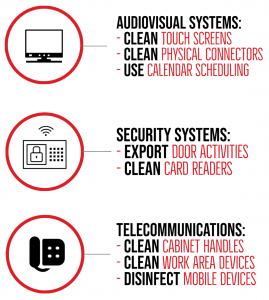 Changing operational approaches to technology systems is one of the simplest ways to take steps toward limiting the spread of infectious diseases. For audiovisual systems this includes cleaning touch screens and physical video and audio connectors after each use, per the manufacturer’s guidelines. Employees should also be encouraged to use calendar scheduling for shared rooms rather than walk-up, on-screen room scheduler bookings.
Changing operational approaches to technology systems is one of the simplest ways to take steps toward limiting the spread of infectious diseases. For audiovisual systems this includes cleaning touch screens and physical video and audio connectors after each use, per the manufacturer’s guidelines. Employees should also be encouraged to use calendar scheduling for shared rooms rather than walk-up, on-screen room scheduler bookings.
Operations protocol for security systems can adapt by enabling door activities from the access control system to be exported daily to provide a record of who has come in and out of the building. Card readers should also be cleaned on a daily basis per the manufacturer’s guidelines.
Telecommunications equipment should likewise be kept clean, including cleaning cabinet door handles per the manufacturer’s guidelines after each use. Employees should be encouraged to clean their work area devices, such as phone handsets, laptops, keyboard, mouse, earbuds, and related equipment, at least once a day. Disinfecting wipes should also be provided so that employees can clean shared mobile equipment, such as iPads, digital notebooks, and laptops.
How can current technology systems adapt?
Current audiovisual systems can be adapted to be more touch-free in a variety of ways. For instance, mobile phone, web browser, or PC software-based control applications can be developed based on existing 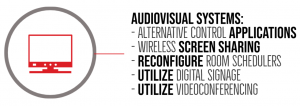 audiovisual control system functions. Using wireless screen sharing systems or software instead of physical connectors and installing motion sensors with the control system for touchless system activation can also discourage the spread of illness through contact with infected surfaces.
audiovisual control system functions. Using wireless screen sharing systems or software instead of physical connectors and installing motion sensors with the control system for touchless system activation can also discourage the spread of illness through contact with infected surfaces.
Current audiovisual systems can also help with managing social distancing between building occupants. By providing reliable and efficient videoconferencing systems, many meetings can be virtual rather than in-person. For gatherings that need to be in-person, modifying room schedulers to include buffer times between meetings can limit physical contact between groups and provide time for shared spaces to be disinfected. Digital signage can also provide reminders to maintain proper social distancing and cleanliness guidelines.
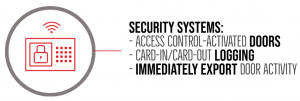 Monitoring who enters and exits a building has become many leadership groups’ top priority, not only to communicate possible virus exposure to regular occupants, but to visitors as well. Fortunately, current security systems can be modified to make this information more easily available. Access control systems can be reprogramed to enable card-in and card-out logging. By installing third-party tools, this information can then be exported immediately after the door is used by an identified credential holder. Access control systems can also be reprogrammed to trigger doors to automatically open upon registering authenticated users’ credentials.
Monitoring who enters and exits a building has become many leadership groups’ top priority, not only to communicate possible virus exposure to regular occupants, but to visitors as well. Fortunately, current security systems can be modified to make this information more easily available. Access control systems can be reprogramed to enable card-in and card-out logging. By installing third-party tools, this information can then be exported immediately after the door is used by an identified credential holder. Access control systems can also be reprogrammed to trigger doors to automatically open upon registering authenticated users’ credentials.
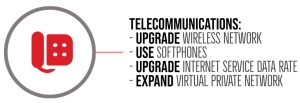 Social distancing for many building managers may also include blended workplaces with staff working remotely for at least part of the week. To maintain the efficiency of workers, managers may need to upgrade the internet service data rate to support on-premise services or deploy/expand virtual private network (VPN) connectivity for remote workers. Some building occupants may want to work in nontraditional or less-occupied spaces within the building, so wireless networks may need to be upgraded to be robust enough to support all users effectively.
Social distancing for many building managers may also include blended workplaces with staff working remotely for at least part of the week. To maintain the efficiency of workers, managers may need to upgrade the internet service data rate to support on-premise services or deploy/expand virtual private network (VPN) connectivity for remote workers. Some building occupants may want to work in nontraditional or less-occupied spaces within the building, so wireless networks may need to be upgraded to be robust enough to support all users effectively.
Upgrading to softphones at workstations can also reduce the amount of equipment used by staff. Softphones are software applications that allow a computer or mobile phone to function as a traditional handset, eliminating that extra point of physical contact. Softphones also allow staff to take business with them wherever they go, whether that’s a conference room, their desk, or home, making the transition from onsite to remote working that much easier.
How will future systems evolve?
Innovation is one of the most exciting aspects of technology as imagination drives the design of the future. Audiovisual systems of tomorrow can be touchless by installing Bluetooth Low Energy (BLE) beacons in conference rooms and other spaces to allow for location-based mobile phone control. Or, by implementing voice-activated control system integration, audiovisual controls could become completely touchless.
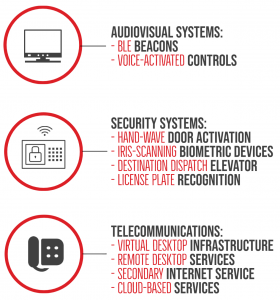 Touchless technology extends to security systems, as well, with the installation of hand-wave activated auto-operator and card reader authentication devices for entry doors and license plate recognition in garages. Biometric devices, such as facial recognition or iris-scanning, can also replace keypads for entrances where two-factor authentication is required. For multi-floor buildings, a destination dispatch elevator control system can be integrated with the access control system to group passengers based on mutual destinations, limiting the time people are in close contact with one another.
Touchless technology extends to security systems, as well, with the installation of hand-wave activated auto-operator and card reader authentication devices for entry doors and license plate recognition in garages. Biometric devices, such as facial recognition or iris-scanning, can also replace keypads for entrances where two-factor authentication is required. For multi-floor buildings, a destination dispatch elevator control system can be integrated with the access control system to group passengers based on mutual destinations, limiting the time people are in close contact with one another.
Telecommunications and information technology systems are now being designed to better support remote working. Deploying virtual desktop environments and remote desktop services access gateways enable building staff to easily work remotely depending on protocols or comfort level. Likewise, many leadership groups may want to consider migrating on-premise services to cloud-based services, as well as increasing internet circuit size to the main office to make information more easily accessible for remote workers.
However, relying so heavily on internet services (ISP) can pose a risk, which can be lessened by installing secondary internet service for redundancy to ensure remote workers can maintain the same connectivity and efficiency as those onsite. Rating systems like WiredScore can help building owners and managers determine the level of internet connectivity and ISP redundancy available within a space to ensure it will support all their technology needs before signing a lease.
Another technology already being used by some companies is real-time location systems. Real-time location systems (RTLS) utilize wrist-worn tags and room level beacons to track users as they move throughout a building. Although commonly used in hospitals to locate doctors, nurses, and and other staff, the technology is now being used in offices to aid in contact tracing and more accurately determine who may have come in contact with a sick individual.
Where can I learn more?
Read “What is WiredScore?” to learn about how essential a reliable technology infrastructure is to today’s offices.
References
¹Sarah Miller, R. K. (2020). Are There More Bacteria on Computer Keyboards Than Toilet Seats? Retrieved September 11, 2020, from National Center for Health Research: https://www.center4research.org/bacteria-computer-keyboards-toilet-seats/










